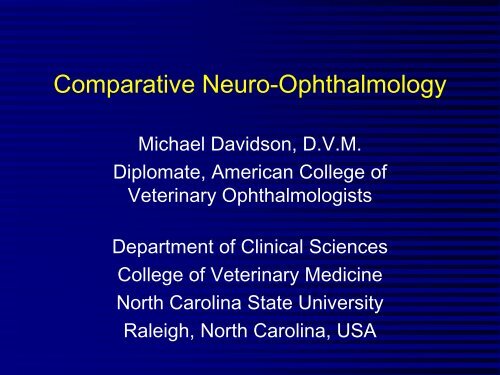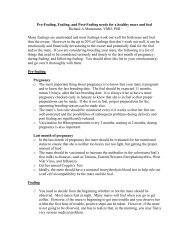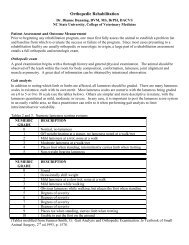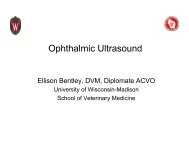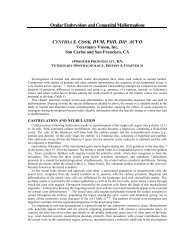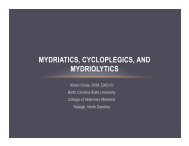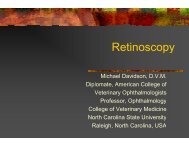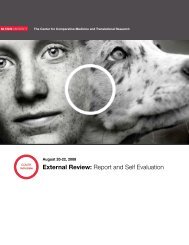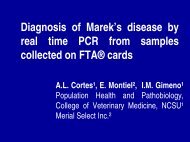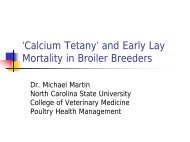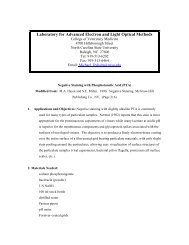Comparative Neuro-Ophthalmology - North Carolina State ...
Comparative Neuro-Ophthalmology - North Carolina State ...
Comparative Neuro-Ophthalmology - North Carolina State ...
- No tags were found...
Create successful ePaper yourself
Turn your PDF publications into a flip-book with our unique Google optimized e-Paper software.
<strong>Comparative</strong> <strong>Neuro</strong>-<strong>Ophthalmology</strong>Michael Davidson, D.V.M.Diplomate, American College ofVeterinary OphthalmologistsDepartment of Clinical SciencesCollege of Veterinary Medicine<strong>North</strong> <strong>Carolina</strong> <strong>State</strong> UniversityRaleigh, <strong>North</strong> <strong>Carolina</strong>, USA
<strong>Ophthalmology</strong><strong>Neuro</strong>ophthalmology<strong>Neuro</strong>logy
Suggested Reading• Shamir MH, Ofri R. <strong>Comparative</strong> <strong>Neuro</strong>-ophthalmology. InVeterinary <strong>Ophthalmology</strong>, Gelatt KN ed. BlackwellPublishing, Oxford, UK, 1406-1469, 2007.• Walsh and Hoyt’s Clinical <strong>Neuro</strong>-<strong>Ophthalmology</strong>: TheEssentials. Miller NR, Newman NJ, eds. 6th EditionWilliams and Wilkins, Philadelphia, 2004.• Scagliotti, RH. <strong>Comparative</strong> <strong>Neuro</strong>-ophthalmology. InVeterinary <strong>Ophthalmology</strong>, Gelatt KN ed. Lippincott,Willliams and Wilkins, Philadelphia, 1307-1400, 1999.Note that, with his kind consent, sections of thesenotes and presentations were borrowed from Dr.Scagliotti’s chapter. Dr. Scagliotti is still considered bymany to be the international veterinary expert in this area,and his chapter is essential (albeit challenging) reading.
Anatomic Pathways:Afferent Arm of PLR• Retina• Optic nerve• Optic chiasm• Optic tract• Pretectal nuclei• CNIIIparasympatheticnucleiRetinaOpticNerveOpticChiasmLGBOptic TractPTNCNIII parasympathetic nuclei
AFFERENT ARM OF PLR:• rod/cone photoreceptors• retinal bipolar cells• retinal ganglion cells whose axonscomprise bulbar, orbital, and prechiasmaloptic nerve• intrinsically photosensitive RGCs*
Optic Nerve• Species specificmyelinated axons
• optic nerve fibers convergeat chiasm with speciesdependent differentialdecussation of fibers:- primate 50%- feline 65%- canine 75%- equine, bovine,porcine 80-90%- rodents 97%- mostsubmammals 100%**Afferent Arm of PLR
Afferent Arm of PLR• Post-chiasmal opticnerve fibers (optictract):- 20% of fibers synapsein pretectal nuclei byrostral colliculis(diencephalon/midbrain)= visual reflexes,PLR- 80% of fibers to dorsallateral geniculatenucleus (thalmus) =visual fibersLGB80%OptictractPTN20%
LG BodyPTN; R.ColliculusII
Intrinsically PhotosensitiveRetinal Ganglion Cells (ipRGC)Berson, DM, Dunn FA, Takao, M. Phototransduction by retinal ganglioncells that set the circadian clock. Science 2002; 295: 1070-3.• Subset of RCG (2%) that are photosensitive and containmelanopsin• Project to brain centers that control non-image formingfunctions including PLR and circadian related behavior• In normal retina, input to ipRGC predominately fromrod/cones, which regulate acute changes in pupil size;ipRGC control sustained pupil size in response toenvironmental light levels• ipRGC capable of generating PLR without rod/cone input,requires high intensity light in ~480nm wavelengths (blue)
Afferent Arm of PLR• pretectal nuclear fibers:- at caudal commisure,second decussationoccurs to reach CNIIIparasympathetic nuclei,results in:• in primates directPLR=indirect PLR• in sub-primatemammals, direct PLR> indirect PLR(dynamic contractionanisicoria)CentraldecussationPTNCNII nuclei
Efferent PLR Pathway• pre-ganglionic fibers =anteriomedian nucleus andventral segmental area(Edinger-Westphal nucleus)• fibers exist mesencephalonwith CN III with motor fibers,diverge in orbital cone nearciliary ganglion• synapse in ciliary ganglion• short ciliary nerves:- dog = 5-8 short ciliarynerves….mixed fibers withparasympathetic, sensoryafferent from CN V (nasociliarynerve)- cat = 2 short ciliary nerves(malar and nasal), onlyparasympatheticCiliaryganglionCNIIIShort ciliarynervesLGBPTNCNIII parasympathetic nuclei
Postganglionic, ParasympatheticCiliary GanglionCatNasal N.Malar N.lateralmedial
• Mammalian species:- smooth muscleIris Musculature<strong>Neuro</strong>physiology- sphincter mm = cholinergic (parasympathetic),through short ciliary nerves; acetylcholine- dilator mm. = adrenergic (sympathetic), through longciliary nerves; norepinephrine- reciprocal innervation with inhibition of antagonist irismm.• Sub-mammalian species:- Skeletal muscle- Voluntary control of pupillary movement
Ciliary Body Innervation andAccommodation• Postganglionic efferentparasympathetic throughshort ciliary nerves• Postganglionic efferentsympathetic through longciliary nerves(disaccomodation)• Longitudinal, radial, circularciliary body mm.• Primates=cholinergic stimulation⇒ ciliary mm. contraction⇒relaxation of zonules ⇒increased axialdistance/curvature(disaccomodation occursthrough sympatheticinnnervation causing opposite)• Carnivores (cat, raccoon,groundsquirrel)=accommodationthrough anterior change in lensposition within eye (“translation”possible due to morelongitudinal mm.)
Oculo-Pupillary Reflex• Afferent arm = ophthalmic division ofCNV• Efferent arm = parasympathetic divisionof CN III• Sensory stimulation of corneal (sclera)resulting in miosis and ciliary mm.spasm
Axon Reflex• stimulation of ophthalmic division of CN V (cornea,conjunctiva, eyelids)- prodromic axoplasmic flow/transmission- antidromic flow through terminal branches of CNVinnervating iris and ciliary body• release of AcH, prostaglandins, substance P, vasoactivecompounds, other inflammatory mediators• miosis, disruption of blood-aqueous barrier, ocularhypertensionBito, LZ. Species differences in the responses of the eye to irritation andtrauma: a hypothesis of divergence in ocular defense mechanisms, andthe choice of experimental animals for eye research. Exp Eye Res 1984Dec;39(6):807-29
Factors Modifying the Pupil and PLR• active = direct adrenergic input frompsychosensory stimulation• passive = supranuclear inhibition ofparasympathetic fibers of CN III- descending, inhibitory pathways from cortex to CNIIInuclei- this inhibition lost with sleep, anesthesia, opiodes,extensive cerebral cortical lesion….resulting in miosis
Evaluating Pupillary Light Reflexes• Evaluate resting pupil size in room and dim light• Evaluate direct and indirect (consensual) PLR withhalogen bulb light source; temporal retina:- in sub-primate mammals, dynamic contraction anisocoria(direct PLR > indirect PLR)- in most submammals, no consensual PLR due tocomplete decussation at chiasm (note pseudo-indirectPLR in birds)• Swinging Flashlight test• High intensity blue light source can help distinguishouter retinal v. inner retinal disorders (ipRGC)
Swinging Flashlight Test• Light alternately shifted from one pupilto other, with 2-3 seconds of directstimulation in each eye• Normal...both pupils constrict to equaldegree when stimulated, illuminated eyeproduces slightly more constriction
Swinging Flashlight Test• “Positive” test (Marcus-Gunn pupil)…illuminatedeye dilates..….unilateral prechiasmal optic nerveor retinal disease• ”Pupillary escape” (dilate slightly after initialcontraction):- can be normal (adaptation of stimulatedretina)- incomplete unilateral, prechiasmal lesions,results from scatter illumination entering(fellow) normal eye• “Positive” test followed by “cover-uncover” test(ambient light is stimuli) to eliminate influence ofscatter illumination
Dark Adaptation Test• assessment of pupillary size after 5minutes in dark• examine with direct ophthalmoscope,turned on immediately prior toassessment
Dark Adaptation Test• normal = both pupils dilate fully andsymmetrically• mechanical restriction problems = affected pupilfails to dilate• afferent and efferent lesions = both pupils dilate• sympathetic dennervation (Horner’s syndrome)= affected pupil fails to dilate, anisicoriaaccentuated by dark adaptation
Afferent arm=vision and PLR abnormalCortical=vision abnormal, PLR normalEfferent=PLR abnormal, vision normalPLR and visionalteredPLR normal andvision altered
Retinal Chain, Intraocular RetinalGanglion Cell Lesions• if unilateral, anisicoria withlarger pupil ipsilateral tolesion• deficit or absence of directand consensual (to felloweye) PLR• positive swinging flashlighttest (Marcus-Gunn pupil) andcover-uncover test• normal dark adaptation test• visual deficits/blindness• PLRs may persist withadvanced (outer) retinaldisease and visual deficits(ipRCGs)• funduscopic exam
Unilateral Prechiasmal OpticNerve Lesions• signs identical toretinal disorders
Unilateral Optic Tract Lesions• similar to unilateral retinal orprechiasmal optic nerve butdilated pupil contralateral tolesion• subtle anisicoria• negative (normal) swingingflashlight test• more miotic pupil persists in thesame eye (ipsilateral to lesion)regardless of which eye isstimulated• visual field contralateral toaffected tract is diminished orlost- contralateral homonymoushemianopia- vision loss most obvious in eyecontralateral to lesion
Bilateral Retina, Optic Nerve or Tract, OpticChiasm or Posterior Commissure Lesions• bilateral mydriasis, PLRdeficits, visual deficits• lesions in both retinas >chiasm > both optic nerves >both optic tracts• lesions in central chiasmdestroying only crossedfibers:- produce equal, but largerthan normal pupils- paradoxical pupil = direct andconsensual PLRs present,more constricted pupilopposite side stimulated (i.e.consensual > direct PLR)
• ipsilateral dilated pupil• nonreactive (ipsilateral) pupil todirect and indirect light• normal dark adaptation test• preganglionic:- generally motor andpupillomotor (totalophthalmoplegia)• postganglionic:- pupillomotor fibers only(internal ophthalmoplegia)- hemipupil in cats if affectingonly one short ciliary nerve- supersensitivity toparasympathomimeticsEfferent Arm Lesions
Internal Ophthalmoplegia• parasympatheticefferent dennervation,ocular movementunaffected• pupillomotor fiberssuperficial in (medial)CNIII, so can bepreferentially damagedwith no motordysfunction (motordysfunction = “externalophthalmoplegia”)
ExternalOphthalmoplegia• motor dennervation of CNIII• ptosis (levator mm)• lateral strabismus, inability torotate globe dorsally,ventrally, or medially (medial,dorsal, ventral rectii, ventraloblique)• isolated externalophthalmoplegia rare,generally with central lesionsaffecting (motor) nuclearcenters
Total Ophthalmoplegia• internal and external ophthalmoplegia• preganglionic (re: ciliary ganglion)lesion, generally severe central lesion
Pharmacologic Localization of Lesions ofAutonomic Innervation to Eye• Direct testingstimulates receptorActionpotentialSynapticfissurereceptor• Indirect testingaffects release orreuptake ofneurotransmittorPresynapticaxonpreganglionicEliminationof NTpostganglionicEffectorSympatheticParasympathetic
Limitations/Caveats in PharmacologicTesting for Autonomic Disorders• endogenous psychosensory stimulation• control eye• quantity of absorbed drug affected byvolume, corneal epithelium, etc• prior drug action (24 hours minimum)• partial lesions, partial dennervationhypersensitivity• pre-ganglionic lesion, partialhypersensitivity
Pharmacologic Testing withParasympathetic Denervation• hypersensitivity > with ganglionic or postganglionic lesions• pharmacologic testing distinguishes from atropine blockade oriridal disease (atrophy, synechia) and aids in lesion localization:- 0.5% physostigmine (indirect parasympathomimetic, allows buildup ofacetylcholine at synaptic fissure):• postganglionic = no constriction• central/preganglionic = rapid constriction before normal, control eye- 2% pilocarpine (direct parasympathomimetic):• 24 hours post indirect agent testing• confirms lesion is neurologic• postganglionic lesion constricts sooner than normal eye
Oculosympathetic PathwayA. Iris sphincter mm.Iris dilator mm.• sympatheticinnervation:- central- preganglionic- postganglionicCranialcervicalganglionCervical spinalcordLateral tectotegmentaltractThoracic spinalcord T1-T3Cervicalsympathetictrunk
Efferent Sympathetic Pathway:1st Order <strong>Neuro</strong>ns• sympathetic fibers arise from hypothalmos• lateral tectotegmentospinal tract• descend ipsilaterally through brain stemand lateral funiculus of spinal cord• synapse in preganglionic cell bodies in graymatter of intermediolateral column of spinalcord T1-T4
Efferent Sympathetic Pathway:2nd Order <strong>Neuro</strong>ns• rami communicans through ventral roots• thoracic sympathetic trunk• cervicothoracic and middle cervicalganglia, cervical sympathetic trunk• synapse in cranial cervical ganglion(caudomedial to tympanic bullae) withpostganglionic sympathetic neurons
Efferent Sympathetic Pathway: 3rdOrder <strong>Neuro</strong>ns• postganglionic fibers join tympanic branch of CN IX(glossopharyngeal n.) to form caroticotympanic nerves• over promontory of middle ear• exit middle ear and enter cavernous sinus• join CN V• most fibers pass through ophthalmic division of CNV, tonasociliary nerve (to upper eyelid, dilator mm. andsmooth mm. of orbit)• enter globe via long ciliary nerve• suprachoroidal space to anterior segment• some fibers through maxillary division of CNV toinfraorbital/zygomatic nerve to supply lower nictitansand lower eyelid
Efferent Sympathetic Pathway:3rd Order <strong>Neuro</strong>ns
Horner’s Syndrome• protrusion of nictitans• ptosis• miosis• enophthalmos• cutaneous facial andcervial hyperthermiaand decreasedsweating (peripheralvasodilitation)
• miosis (recovery of pupil morelikely with preganglionic vs.postganglionic lesions)• anisicoria (dark adaptation, andexcitement accentuate)• sympathetic ptosis and “reverseptosis”• narrowed palpebral fissure(ptosis and reverse ptosis createsimpression of “apparent”enophthalmos even if notpresent)• enophthalmos (variably present)• sympathetic protrusion ofnictitans (enophthalmosaccentuates)Efferent Sympathetic:Horner’s Syndrome
Horner’s Syndrome in Large Animals• signs more subtle than dogs/cats• ptosis most consistent finding, miosis inconsistent• ipsilateral cutaneous facial and cervical hyperthermia• cattle = ipsilateral lack of sweating (anhydrosis, detectedin nose), vascular engorgement of pinna (sweatingmediated by alpha adrenegic receptors)• horse = ipsilateral facial sweating (vasodilatation andincreased blood flow from decreased vasomotor tonus)- entire ipsilateral head and body = first order lesion- ipsilateral head and neck = second or third order lesion
Pharmacologic Testing• 6% cocaine…blocks reuptake of norepinephrine- no mydriasis confirms Horner’s syndrome• 1% hydroxyamphetamine…causesnorepinephrine release- postganglionic = no or incomplete mydriasis- preganglionic = normal mydriasis• 10% phenylephrine- hypersensitivity with postganglionic- mydriasis in 5-8 minutes- retraction of nictitans and resolution of ptosis alsooccurs
Localization of Pupillary Abnormalities• rule out psychosensory stimulation• rule out oculopupillary/axon reflexes• rule out non-neurologic disorders- mechanical or structural iris abnormalities- pharmacologic blockade• if neurologic disorder, define effects on:- pupillary diameter or shape- response to dark adaptation testing- pupillary light reflex- vision (if afferent arm lesion prior to LBG)• funduscopic exam, complete neurologic exam
• AnisicoriaLocalization of PupillaryAbnormalities- unilateral mydriasis- unilateral miosis• Bilateral mydriasis• Bilateral miosis
Anisicoria: Unilateral Mydriasis• Efferent arm lesions:- obvious anisicoria- absent direct PLR, normal indirect PLR fromaffected eye to fellow eye- +/- external ophthalmoplegia- supersensitivity to parasympathomimetics- “D” and “reverse D” in cat if postganglionic
Anisicoria: Unilateral Mydriasis• Afferent arm lesions:- less obvious anisicoria- absent direct PLR and indirect PLR fromaffected eye/side to fellow eye if prechiasmal- positive swinging flashlight test if prechiasmal- visual deficits
Anisicoria: Unilateral Mydriasis• Cerebellar lesions- generally contralateral mydriasis +/-ipsilateral nictitans protrusion- both pupils respond to light stimuli• Acute cerebral swelling- ipsilateral mydriasis from compression ofCN III
Anisicoria: Unilateral Miosis• Efferent sympathetic- ipsilateral miosis- anisicoria accentuated by dark adaptation- further constriction on light stimulation- other clinical findings of Horner’s syndrome- pharmacologic localization
Localizing Horner’s Syndrome withOther <strong>Neuro</strong>logic Signs• cervical spinal cord=tetraparesis• C6-T2 spinal segments =forelimb monoparesis withreduced spinal reflexes• cervical sympathetic trunk= no other deficits• inner/middle ear =possible CN V, VI, VII,VIII, IX deficits• cavernous sinus =possible CN III, IV, V, VIdeficits• retrobulbar space =concurrentparasympatheticdenervation, possibleCN II, III, IV, V, VI
Bilateral Mydriasis• Bilateral afferent- retinal > optic chiasm > bilateral optic nerve> bilateral optic tract- visual deficits• Bilateral efferent- bilateral CNIII uncommon- brainstem lesions affecting parasympatheticnucleus of CNIII
Bilateral Miosis• Extensive brain dysfunction (loss ofsupranuclear inhibition to CNIII)• Rostral collicular lesions
Questions?


